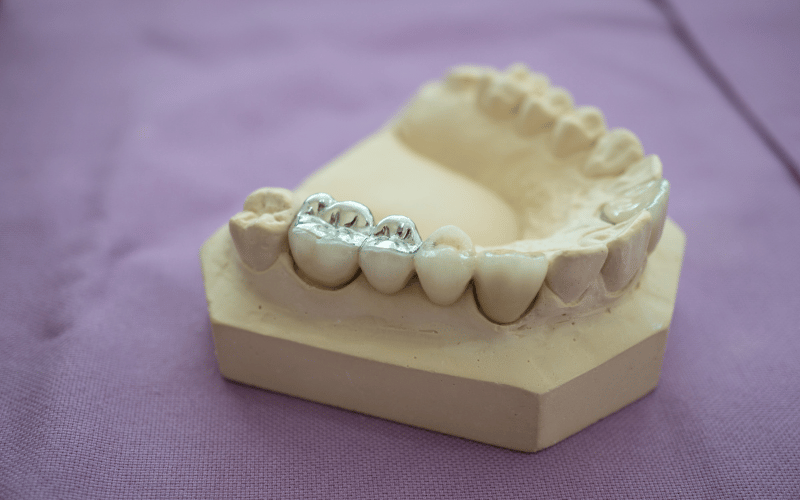Dental fillings are restorative materials that repair teeth damaged by decay, fractures, or wear. Typically composed of materials like amalgam, composite resin, or porcelain, fillings help restore the tooth’s structure, preventing further decay and alleviating sensitivity.
The dentist removes the damaged portion, cleans the cavity, and fills it with the chosen material. Amalgam fillings, made of metal alloy, are durable and cost-effective, while tooth-colored composite resin fillings blend seamlessly with natural teeth for a more aesthetically pleasing result.
Regular dental check-ups aid in detecting the need for fillings, ensuring timely intervention, and preserving oral health.
Benefits Of Dental Fillings
1. Tooth Preservation: Dental fillings help preserve natural teeth by addressing cavities and preventing further decay. They restore the tooth’s structure, maintaining its functionality and integrity.
2. Pain Relief: Filling cavities alleviates toothache and discomfort associated with decay. By sealing the affected area, fillings reduce sensitivity to hot, cold, and sweet stimuli, improving oral comfort.
3. Prevention of Further Damage: Fillings act as a barrier against bacteria, preventing the spread of decay and potential damage to adjacent teeth. This proactive approach helps avoid more extensive dental procedures in the future.
4. Cosmetic Improvement: Tooth-colored fillings, made of materials like composite resin, look natural. They can match the tooth’s color, enhancing aesthetics and maintaining a seamless smile.
5. Restored Functionality: Dental fillings restore the functionality of affected teeth, enabling normal biting and chewing. This restored functionality ensures patients enjoy a varied and nutritious diet without discomfort or limitations.
5 Different Types of Dental Fillings
1. Amalgam Fillings
Amalgam fillings, a traditional dental restorative material, consist of a durable alloy of metals, including mercury, silver, tin, and copper. Widely used for over a century, amalgam fillings offer strength and longevity, making them suitable for posterior teeth subjected to high chewing forces.
Despite concerns about mercury content, extensive research supports their safety. Amalgam’s cost-effectiveness, durability, and ease of placement make it a practical choice for restoring cavities in areas with significant stress.
While tooth-colored alternatives exist for aesthetic concerns, amalgam fillings remain reliable and efficient for restoring damaged teeth, especially in load-bearing regions.
2. Composite Dental Fillings
Composite fillings are a popular dental restoration option made from plastic resin and finely ground glass particles. These tooth-colored fillings offer aesthetic benefits, blending seamlessly with natural teeth for a discreet appearance.
Unlike traditional amalgam fillings, composites bond directly to the tooth, preserving a more natural structure and requiring less removal of healthy tooth material. They are particularly suitable for front teeth and smaller cavities.
Although they may have a slightly shorter lifespan than amalgam, advancements in material technology have improved durability. Because of the cosmetic appeal, versatility, and ability to restore function and aesthetics, the dentist uses composite fillings
3. Gold Fillings
Gold fillings, also known as gold inlays or onlays, are dental restorations crafted from a mixture of gold and other metals. Renowned for their durability and biocompatibility, gold fillings are resistant to corrosion and wear, making them suitable for withstanding biting forces in posterior teeth.
While less common due to aesthetic considerations and cost, gold fillings provide long-lasting strength and require minimal removal of tooth structure. The precision of their fabrication contributes to a secure fit.
Although not tooth-colored, their durability and biocompatibility make gold fillings viable for those prioritizing longevity and minimal tooth sensitivity.
4. Ceramic or Porcelain Fillings
Ceramic or porcelain fillings, or onlays, are tooth-colored restorations crafted from durable materials like porcelain or ceramic compounds.
These highly aesthetic fillings resemble natural teeth, making them popular for visible areas.
Their biocompatibility and resistance to staining contribute to their appeal. Unlike traditional amalgam, ceramic fillings require minimal removal of tooth structure and provide excellent durability.
Their ability to bond securely to the tooth enhances overall stability.
While costlier than some alternatives, ceramic fillings balance aesthetics and functionality, making them preferred for individuals seeking durable, natural-looking dental restorations.
5. Glass Ionomer Dental Fillings
Glass ionomer fillings are dental restorations composed of a blend of glass powder and an organic acid. These tooth-colored fillings are known for their versatility, as they can release fluoride, aiding in cavity prevention.
While not as durable as some alternatives, they are valued for their ability to bond to tooth structure, making them suitable for non-load-bearing areas.
Pediatric Dentistry uses Glass ionomer fillings due to their fluoride-releasing properties and ease of application.
While not as aesthetic as some options, their unique characteristics make them a practical choice for specific dental situations, promoting overall oral health.
Choosing the Right Filling for You
1. Consider Aesthetics: If appearance is a priority, tooth-colored options like composite or porcelain fillings offer a natural look, blending seamlessly with your teeth. Discuss aesthetic preferences with your dentist.
2. Location of the Cavity: The location of the cavity influences the choice of filling material. Amalgam and gold may be suitable for back teeth, while composite or porcelain is usually preferred for visible front teeth due to their cosmetic appeal.
3. Durability and Strength: Evaluate the durability required for the specific tooth. Amalgam and gold are known for their strength in load-bearing areas, while composite and porcelain are suitable for smaller, less stressed areas.
4. Allergies and Sensitivities: If you have metal allergies or sensitivities, discuss this with your dentist to avoid materials like amalgam. Alternative options, such as composite or porcelain, may be more suitable.
5. Cost Considerations: Different filling materials come with varying costs. Discuss the financial aspect with your dentist and consider your budget when deciding.
6. Longevity: Consider the expected lifespan of the filling material. While materials like gold and amalgam are known for durability, composite and porcelain have seen advancements in durability over the years.
7. Dentist’s Recommendation: Trust your dentist’s expertise. When recommending the most suitable filling material, they will consider your oral health, preferences, and specific needs.
8. Insurance Coverage: Check your dental insurance coverage to understand the financial aspects of different filling materials. Some insurance plans may have preferences or limitations on coverage for certain fillings.
9. Potential Future Treatments: Discuss potential treatments and their interaction with the chosen filling material. Understanding the long-term implications can help in making an informed decision.
10. Preventive Properties: Some materials, like glass ionomer, release fluoride, offering additional cavity prevention. If preventive measures are a priority, discuss these aspects with your dentist during decision-making.
Final Words!
In choosing the right dental filling, considerations such as aesthetics, location, durability, and budget are vital. At DNA Dental Studio Burbank, our expert team guides you through these factors to ensure optimal oral health.
Whether it’s the strength of amalgam, the cosmetic appeal of porcelain, or the versatility of glass ionomer, we prioritize your preferences and overall well-being.
For personalized care and the latest dental solutions, trust DNA Dental Studio Burbank for your dental fillings in Burbank.
Smile confidently with the perfect choice. Schedule your consultation today and let your smile shine brighter than ever!


